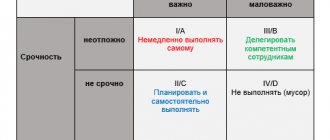Personal growth
Why do you think some projects and companies can achieve success, while others face constant failure? And the answer to this question is quite simple - there are the main factors for achieving a company’s success, which have been used by entrepreneurs and corporations for the past 50 years. And this is not surprising, because their creator has provided a lot of evidence of the effectiveness of this tool.
You're unlikely to listen to the advice of a fat nutritionist or an exhausted therapist. It's the same in business. Any company that engages in management consulting must set an example of prosperity. The creator of the management tool Key Factors for the Company's Success was Ron Daniel in 1961. He explained from a scientific point of view the mechanism of success of departments and the company as a whole.
What are the key success factors?
A key success factor (KSF) is a certain number of areas of activity in which achieving high results guarantees success for a person, company or division in the competition. Simply put, these are the factors or areas on which you need to focus your attention in order to achieve success.
The main success factors are those areas of activity that must work without any major disruptions, only then will this guarantee the success of an individual manager or the entire company. Those. These are the few areas that need to be given special and constant attention to get the most positive results from them.
Key Performance Indicators (KPIs) should not be confused with Key Success Factors (KSFs). KPI is a unit of measurement for success, and KPI is what contributes to success. For example, CFU is the opening of a new store with more favorable purchasing conditions. Actually, due to this, KPIs will be achieved. And the KPI is, let’s say, there should be 10 new clients per week.
Assessing the competitive positions of rival enterprises in the industry
This part of the analysis identifies strategic groups of enterprises operating in the industry.
Despite the fact that all enterprises are united by the fact that they belong to a certain industry, they can differ significantly from each other in various parameters, for example, in size, in the markets in which they operate, in the range of additional services offered, etc. The strategic group consists of competing enterprises with similar competitive approaches and market positions. The technique of identifying strategic groups is called strategic group mapping. The sequence of actions is as follows.
1. Determination of characteristics that differentiate enterprises in the industry. Typical characteristics may include:
- price/quality ratio (high, medium, low);
- geographic market (local, regional, national, group of countries, global);
- degree of vertical integration (absent, partial, high);
- assortment (wide, narrow);
- distribution channels used (one, several, various types);
- level of service (absent, limited, most complete).
- In specific cases, additional characteristics that are important for analysis are used.
2. Placement of enterprises on a two-coordinate map using pairs of specified characteristics.
3. Uniting enterprises falling into one strategic space into one group.
The general procedure for mapping strategic groups is described here, although the actual technique is more complex. For example, if the selected characteristics are a priori correlated with each other, then such a map is practically useless. To avoid mistakes in the initial period of working with this tool, it is advisable to use pairs of all selected characteristics in order to select those cards (one or more) of strategic groups that seem most interesting.
Examples and features of key success factors
1. Anyone involved in company strategy must be a professional in the area of industry or business in which the company is developing, because any area has its own individual success factors.
2. The success factor of a company must be divided into two areas: personnel management and process management. Neither area should be ignored.
3. An important component in determining the CFU is the company’s mission. The company's success factor is a logical continuation of the task.
4. Nowadays, very often the main factor in achieving success is process improvement through modern technologies.
5. For manufacturers, the success factor is most often low production costs, quality control, and high labor productivity. The best options for CFU will be a balance of these three indicators.
6. For distribution companies, the key success factor is the creation of a global distribution network or retail presentation of goods through competent merchandising.
7. Company success factors related to marketing - advertising, brand strength, guarantees.
8. In the service sector, the success of a company depends on design, speed of service delivery and, of course, on the qualifications of employees.
9. If we take the human factor, then the success factor here can be: a culture of communication, an effective method of accepting change, an effective communication system, the development of team spirit
Assessing the forces of competition
When assessing the forces of competition, M. Porter’s model is used, according to which competition in any industry is the interaction of five competitive forces:
- competition among existing firms in the industry;
- the potential threat of new competitors entering the industry;
- enterprises in other industries producing substitute goods;
- suppliers;
- consumers.
The most significant competitive force is usually competition among existing firms in the industry.
It manifests itself in the desire of rival enterprises to improve their market position, in offensive actions in order to rise above competitors or defeat an individual competitor, in defensive tactics in order to defend their positions. The tools of intra-industry competition are: prices, product quality, appearance of products and packaging, guarantees, additional services, advertising, the ability to implement innovations, the power of one’s own or partner distribution network, and others. At this stage of the analysis, the task is to generally characterize intra-industry competition, determine the rules by which it is conducted in a given industry, and assess the strength of intra-industry competition at present and in the future.
The threat of new firms entering the industry is the next competitive force that needs to be analyzed. Serious consequences of the emergence of such firms are manifested in a decrease in the profitability of the industry, the struggle for the redistribution of markets, and an increase in marketing costs. The magnitude of the threat of the emergence of new firms depends on the profitability of the industry in relation to the average in the national economy and on the presence and significance of entry barriers.
Barriers to entry are obstacles that must be overcome to compete successfully by creating the necessary reserves to do so, and which do not usually exist for firms within an industry. Barriers to include:
- Economies of scale. If this factor operates in the industry, then the newcomer must immediately enter large volumes in order to be competitive. This requires significant investment and organizational expertise.
- Difficulty in accessing production experience and production secrets.
- Customer orientation towards well-known brands and their commitment to products known to them.
- Large capital requirements unrelated to economies of scale.
- Specific industry advantages of existing firms, which a priori provide them with lower cost opportunities. For example, this may be related to access to raw materials or other resources, or to the most advantageous location.
- Access to distribution channels. Existing firms are one way or another trying to bind members of distribution channels to themselves, which creates additional difficulties for newcomers.
- State regulatory policy in relation to this industry.
- International trade restrictions.
Suppliers, as a competitive force, can influence the competitive position of the industry by raising prices for their products. The extent to which they are able to do this, or how strong the threat of doing so, depends on the strength of the suppliers. are considered to have great power if the following conditions exist:
- The products they supply are critical to the quality of the industry's products.
- There is little or no competition from substitute products.
- Supplier concentration is higher than in the industry.
- Suppliers' products are differentiated.
- The industry is not one of the most important customers.
Buyers, like suppliers, can influence the competitive situation in an industry with greater or lesser power. Buyers are considered to have great power when:
- products are standardized and not differentiated;
- buyers are insensitive to the costs associated with replacing suppliers;
- the quality of products from buyers does not depend decisively on the products of the industry;
- buyers are well informed about the industry situation.
The most unpleasant competitive situation in an industry occurs when competition among operating firms is strong, barriers to entry are low, competition from substitute products is strong, and suppliers and customers have sufficient power to influence the situation in the industry to achieve their goals.
However, even when all five forces of competition are significant, an industry may remain attractive to individual firms that manage to defend their positions through their strategies. A successful strategy must address two issues regarding competitive forces:
- isolate your enterprise as much as possible from the negative influence of industry competitive forces;
- use the current situation in the industry and the rules of the game to your advantage.
Key success factors and development strategy
Step one.
In order to determine the main KFU of the organization, it is necessary to create a “strategic session”, where the company’s managers, who were selected by management, will participate in the planning group.
Step two.
The first thing to do is to think in writing and provide your suggestions for what needs to be learned and what needs to be done by all participants in the session.
Step three.
They read out their proposals with justified arguments.
Step four.
Determining two or three success factors. This is a major part of the process of finding a CFI for a company.
Step five.
Based on the selected KFU, make a SWOT analysis, where weaknesses and strengths, threats and opportunities are determined based on and taking into account key success factors. In the future, SWOT analysis is used for detailed planning to determine the vector of change and the funds allocated for this.
Read also:
100 Best Motivational Quotes from Great People
How to be effective and achieve goals faster?
Determination of the main economic characteristics of the industry
An industry is understood as a group of enterprises whose products have common consumer characteristics and which compete in the same consumer market.
As part of this stage of analysis, it is necessary to obtain answers to the following questions:
- market size;
- market growth rates and industry position in the life cycle (early development, rapid growth, maturity, saturation, aging and stagnation, market and sales decline);
- scale of competition (local, regional, national, group of countries, global);
- the number of competitors and their comparative sizes;
- the number of buyers and their comparative sizes;
- the presence of vertical integration in the industry;
- the ease or difficulty of entering and exiting the industry;
- the pace of technological progress in the industry;
- the degree of differentiation of competitors' products (highly differentiated, weakly differentiated or almost identical);
- presence of economies of scale;
- whether the achieved level of productivity is critical for reducing costs;
- the level of profitability in the industry in comparison with the average in the national economy.
Introduction
Key success factors are factors common to all enterprises in the industry, the implementation of which opens up prospects for improving their competitive position. The point is not whether a particular firm can or cannot currently implement these factors. The challenge is to identify the factors that provide the key to competitive success in a given industry. Identification of CFU for a specific industry is the first step, which should be followed by the development of activities for mastering CFU specific to the industry. This work represents an essential part of developing the strategic plan of the enterprise, taking into account the nature of the goals and objectives of development, as they are imagined by the management of the enterprise. CFU should be considered as the foundation of the developed strategy. FCIs are not the same for different industries, and for a particular industry they can change over time. However, you can try to identify the basic CFUs, some of which are given below. The task of analysts is to identify the 3-5 most important CFUs in the near future, for example, by ranking all the identified factors that are important for a given industry. They should then form the basis of the enterprise strategy.
Analysis of closest competitors: what are their possible actions
The study of specific competing enterprises comes down to an analysis of today's policies and potential steps of their closest competitors.
This is a difficult task, but correctly assessing the actions of competitors gives the company the opportunity to prepare for them and take advantage of emerging opportunities. The intentions of closest competitors may require enterprises to prepare to defend their positions or develop a plan for active offensive actions if there are prerequisites for weakening the positions of their closest competitors. On the other hand, it is necessary to predict the actions of competitors in response to the intensification of their own competitive strategy. It is clear that you cannot predict the future actions of competitors with absolute certainty, but you can get closer to understanding their approaches. The analysis is based on an assessment of the current position of competitors, trends in its change and the competitive strategy used. There are three basic competitive strategies: cost leadership, product differentiation and focus. The procedure for analyzing each competitor can be divided into six stages:
- Assessing the scale of competition: local, regional, national, group of countries, global.
- Assessment of strategic intentions: to be an industry leader, to become an industry leader, to be in a group of leaders, to move into a leading group, to move one or two positions in the industry ranking, to defeat a specific competitor (not necessarily the leader), to maintain one’s position, to survive.
- Goals regarding your market share: aggressive expansion through both acquisition and internal growth, increasing share through internal growth (by reducing the shares of other firms), expansion through acquisition, maintaining existing market share, willingness to cede share to achieve short-term profit goals (emphasis on profitability rather than sales volumes).
- Competitive position: becomes stronger, well fortified, able to defend its position, stays in a certain group, tries to move to a stronger position, becomes weaker but fights, tries to occupy a position that can be defended.
- Nature of actions: predominantly offensive, predominantly defensive, a combination of offensive and defensive actions; aggressive, high risk-taking, conservative imitation.
- Competitive strategy: leadership in cost reduction, focusing on a specific market niche (high-income group of the population, low-income buyers, geographically defined niche, buyers with special needs, etc.); product differentiation based on quality, additional services, technological superiority, assortment, company reputation, etc.
After the activities of each of the closest competitors are examined from this angle, analysts have the opportunity to confidently plan possible specific moves of competitors, the market segment where attacks should be expected, the competitive tools involved (prices, advertising, etc.) and others options. When the possible actions of nearby competitors become clear, it is then possible to plan a system of countermeasures to support one's own strategy, or measures aimed at strengthening one's own strategy, if the position of competitors allows this to be done.











